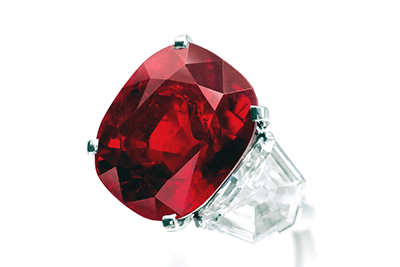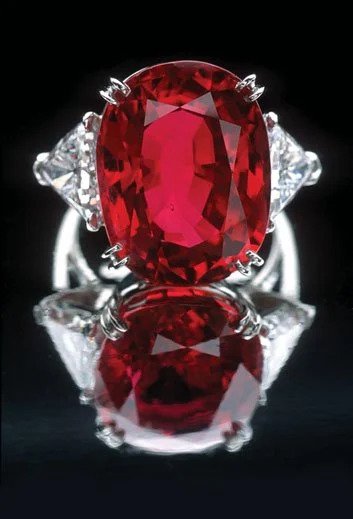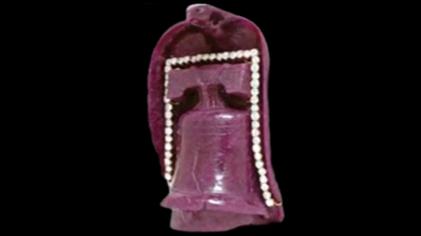Ruby is a pinkish-red to blood-red colored gemstone, that belongs to the corundum family, the same gemstone family as sapphires. The name ruby comes from the Latin word, ruber which means red.
Color is one of the main features that affect a ruby's value, with deep red (also known as pigeon blood rubies) being the most valuable, and sought-after variety of rubies thanks to its bright red color with tones of pink and purple. Myanmar has one of the greater ruby deposits in the world and is particularly known for its pigeon blood rubies. Myanmar's colonial name was Burma and the rubies from Myanmar are still known as Burma Rubies. Australia, Brazil, Japan, Nepal, and Madagascar also have important ruby reserves and mines.
Other factors that affect the value of the stone are clarity, cut, and size/weight. Clarity is the second most important factor, after color, that affects the value of rubies. Some imperfections are expected, as there are no natural rubies without inclusions. Craftsmen who cut and polish the gemstones may correct or minimize some of these imperfections, while others maintain them, especially when they help light reflect better and produce a more intense color. Cut is not as important for rubies as for diamonds, but it also affects their value, because the right cut can better highlight the color and clarity of a stone. The shape and cut of ruby are largely influenced by the original shape of the stone and any imperfections that may affect its value. Rubies are usually cut in oval and cushion shapes, with the heart shape also being a strong favorite. High-quality rubies weighing over a carat are rare but commercial-quality pieces (those chosen mainly for jewellery) are available in a wide variety of sizes. In rubies, the higher the carat weight, the higher the price, as is with diamonds.
Sunrise Ruby

Sunrise Ruby is one of the most expensive rubies in the world. It is named after a 13th-century poem with the same name. Its weight is 25.59 carats, the color is pigeon blood red, and the country of origin is Myanmar (then Burma). In 2015 it was sold to Heidi Horten on auction for $30.42 million, a price quite higher than the initial estimate of $12- $18 million. In 2023, following Horten's death, it was auctioned again for $14.7 million.
Source: tatler.com
Carmen Lucia ruby
 The Carmen Lucia Ruby was mined in 1930 in the Mogock area of Myanmar (then Burma). It weighs 23.1 carats and has a deep red - pigeon blood red - color with strikingly high purity and color saturation. It is set in a platinum ring and framed by two triangular diamonds totaling 2.38 carats. The ring was named after Carmen Lucia Buck, whose husband donated the ring to the collection of the Smithsonian Museum of Natural History in the US in 2004.
The Carmen Lucia Ruby was mined in 1930 in the Mogock area of Myanmar (then Burma). It weighs 23.1 carats and has a deep red - pigeon blood red - color with strikingly high purity and color saturation. It is set in a platinum ring and framed by two triangular diamonds totaling 2.38 carats. The ring was named after Carmen Lucia Buck, whose husband donated the ring to the collection of the Smithsonian Museum of Natural History in the US in 2004.
Source: Smithsonianmag.com
Jewellery of Elizabeth Taylor
Elizabeth Taylor's renowned jewellery collection included several pieces adorned with rubies. Among the actress' most famous ruby jewellery was a set of necklaces, bracelets, and earrings adorned with rubies and diamonds. When Elizabeth Taylor's jewellery collection was auctioned in 2011, the necklace was sold at Cartier Collection for more than $3.7 million, while the bracelet and earrings were sold for $782,500 and $842,500 respectively to a private collector.
 Ruby Liberty Bell Ruby is the largest ruby ever mined. It was found in the 1950s in East Africa, weighing 8,500 carats, and has the shape of the "Bell of Freedom" a symbol of the American Revolution.
Ruby Liberty Bell Ruby is the largest ruby ever mined. It was found in the 1950s in East Africa, weighing 8,500 carats, and has the shape of the "Bell of Freedom" a symbol of the American Revolution.